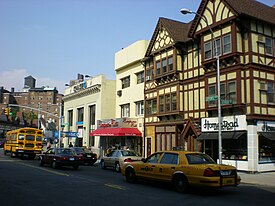Kew Gardens, Queens
| Kew Gardens | |
|---|---|
| Neighborhood of Queens | |

Homestead Gourmet Shop and other stores on Lefferts Boulevard
|
|
 Map showing Maple Grove station in 1891 |
|
| Country |
|
| State |
|
| City |
|
| County/Borough |
|
| Named for | Royal Botanic Gardens, Kew |
| Population | |
| • Estimate (2008) | 25,769 |
| Ethnicity | |
| • White | 66.2% |
| • Black | 7.0% |
| • Hispanic | 20.0% |
| • Asian | 13.1% |
| • Other | 7.4% |
| Economics | |
| • Median income | $61,287 [1] |
| ZIP code | 11415 |
| Area code(s) | 718, 347, 917 |
Kew Gardens is an upper-middle class neighborhood in the central area of the New York City borough of Queens. Kew Gardens, shaped roughly like a triangle, is bounded to the north by the Jackie Robinson Parkway (formerly the Interboro Parkway), to the east by Van Wyck Expressway and 131st Street, to the south by Hillside Avenue, and to the west by Park Lane, Abingdon Road, and 118th Street. Forest Park and the neighborhood of Forest Hills are to the west, Flushing Meadows–Corona Park north, Richmond Hill south, Briarwood southeast, and Kew Gardens Hills east.
Kew Gardens was one of seven planned garden communities built in Queens from the late 19th century to 1950. Much of the area was acquired in 1868 by Englishman Albon P. Man, who developed the neighborhood of Hollis Hill to the south, chiefly along Jamaica Avenue, while leaving the hilly land to the north undeveloped.
Maple Grove Cemetery on Kew Gardens Road opened in 1875. A Long Island Rail Road station was built for mourners in October and trains stopped there from mid-November. The station was named Hopedale, after Hopedale Hall, a hotel located at what is now Queens Boulevard and Union Turnpike. In the 1890s, the executors of Man's estate laid out the Queens Bridge Golf Course on the hilly terrains south of the railroad. This remained in use until it was bisected in 1908 by the main line of the Long Island Rail Road, which had been moved 600 feet (180 m) to the south to eliminate a curve. The golf course was then abandoned and a new station was built in 1909 on Lefferts Boulevard. Man's heirs, Aldrick Man and Albon Man Jr., decided to lay out a new community and called it at first Kew and then Kew Gardens after the well-known botanical gardens in England. The architects of the development favored English and neo-Tudor styles, which still predominate in many sections of the neighborhood.
...
Wikipedia
